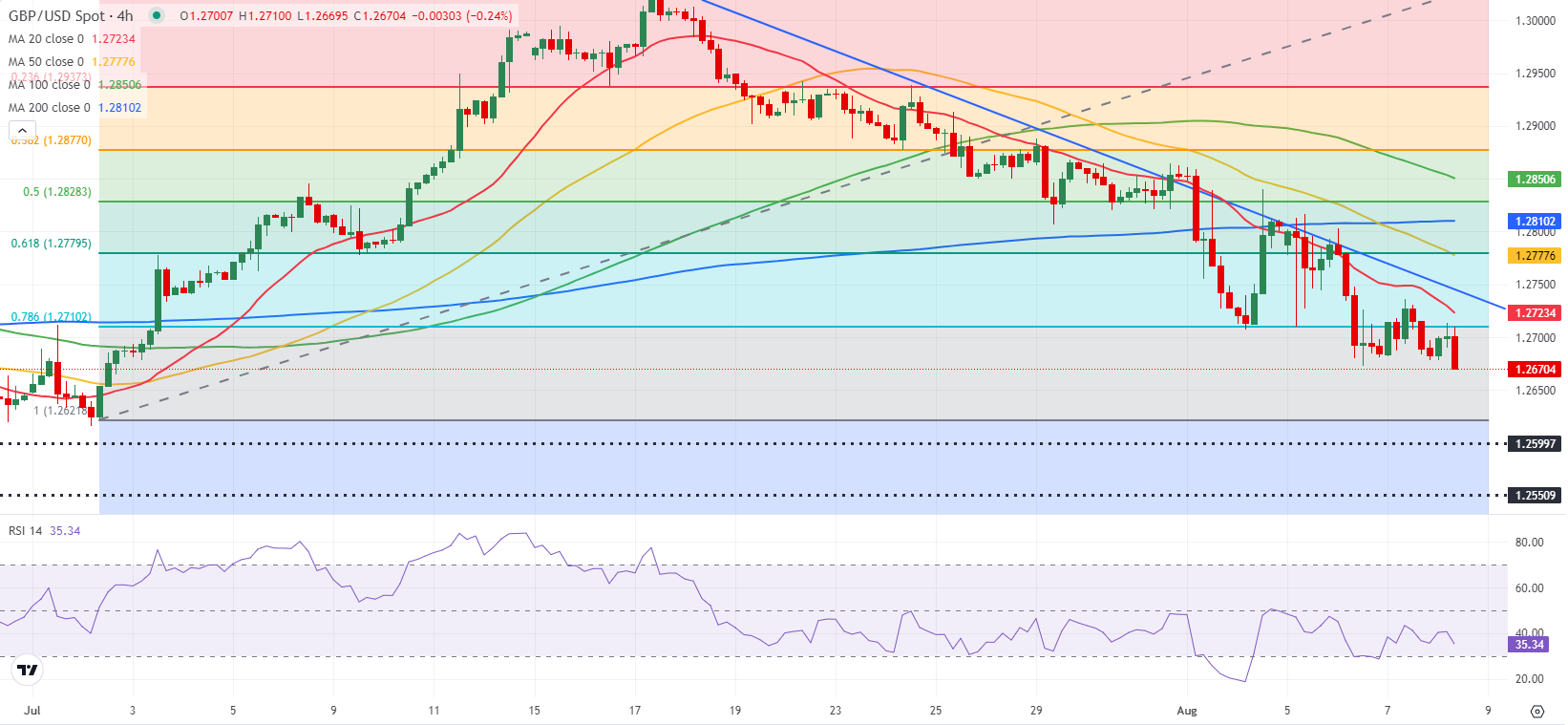- GBP/USD stays under bearish pressure below 1.2700 on Thursday.
- The negative shift seen in risk mood weighs on Pound Sterling.
- Investors await weekly Initial Jobless Claims data from the US.
After recovering above 1.2700 during the European trading hours on Wednesday, GBP/USD erased its gains and closed the day virtually unchanged slightly below this level. The pair stays on the back foot early Thursday and trades at its lowest level in a month since early July.
British Pound PRICE This week
The table below shows the percentage change of British Pound (GBP) against listed major currencies this week. British Pound was the weakest against the Canadian Dollar.
| USD | EUR | GBP | JPY | CAD | AUD | NZD | CHF | |
|---|---|---|---|---|---|---|---|---|
| USD | -0.10% | 1.09% | -0.35% | -0.89% | -0.57% | -0.62% | -0.10% | |
| EUR | 0.10% | 1.11% | -0.40% | -0.92% | -0.46% | -0.63% | -0.11% | |
| GBP | -1.09% | -1.11% | -1.41% | -1.99% | -1.55% | -1.72% | -1.21% | |
| JPY | 0.35% | 0.40% | 1.41% | -0.52% | -0.29% | -0.27% | 0.25% | |
| CAD | 0.89% | 0.92% | 1.99% | 0.52% | 0.36% | 0.28% | 0.62% | |
| AUD | 0.57% | 0.46% | 1.55% | 0.29% | -0.36% | -0.17% | 0.35% | |
| NZD | 0.62% | 0.63% | 1.72% | 0.27% | -0.28% | 0.17% | 0.52% | |
| CHF | 0.10% | 0.11% | 1.21% | -0.25% | -0.62% | -0.35% | -0.52% |
The heat map shows percentage changes of major currencies against each other. The base currency is picked from the left column, while the quote currency is picked from the top row. For example, if you pick the British Pound from the left column and move along the horizontal line to the US Dollar, the percentage change displayed in the box will represent GBP (base)/USD (quote).
The souring market mood seems to be making it difficult for Pound Sterling to stay resilient against its rivals. At the time of press, the UK's FTSE 100 Index was down 1% on the day and US stock index futures were trading marginally lower.
In the second half of the day, the weekly Initial Jobless Claims data from the US will be looked upon for fresh impetus. Markets expect the number of first-time applications for unemployment benefits to come in at 240,000 in the week ending August 3. In case the number arrives above the market expectation, the initial reaction could hurt the USD and help GBP/USD limit its losses.
Nevertheless, GBP/USD could have a difficult time staging a rebound in case safe-haven flows continue to dominate the financial markets in the second half of the day.
GBP/USD Technical Analysis
GBP/USD trades below the descending trend line and the Relative Strength Index (RSI) indicator on the 4-hour chart stays below 40, reflecting a bearish stance in the near term.
1.2620 (static level, beginning point of the latest uptrend) aligns as first support for GBP/USD before 1.2600 (psychological level, static level) and 1.2550 (static level)..
On the upside, first resistance is located at 1.2710-1.2700 (Fibonacci 78.6% retracement of the latest uptrend, psychological level align) ahead of 1.2750 and 1.2780 (Fibonacci 61.8% retracement).
Pound Sterling FAQs
The Pound Sterling (GBP) is the oldest currency in the world (886 AD) and the official currency of the United Kingdom. It is the fourth most traded unit for foreign exchange (FX) in the world, accounting for 12% of all transactions, averaging $630 billion a day, according to 2022 data. Its key trading pairs are GBP/USD, aka ‘Cable’, which accounts for 11% of FX, GBP/JPY, or the ‘Dragon’ as it is known by traders (3%), and EUR/GBP (2%). The Pound Sterling is issued by the Bank of England (BoE).
The single most important factor influencing the value of the Pound Sterling is monetary policy decided by the Bank of England. The BoE bases its decisions on whether it has achieved its primary goal of “price stability” – a steady inflation rate of around 2%. Its primary tool for achieving this is the adjustment of interest rates. When inflation is too high, the BoE will try to rein it in by raising interest rates, making it more expensive for people and businesses to access credit. This is generally positive for GBP, as higher interest rates make the UK a more attractive place for global investors to park their money. When inflation falls too low it is a sign economic growth is slowing. In this scenario, the BoE will consider lowering interest rates to cheapen credit so businesses will borrow more to invest in growth-generating projects.
Data releases gauge the health of the economy and can impact the value of the Pound Sterling. Indicators such as GDP, Manufacturing and Services PMIs, and employment can all influence the direction of the GBP. A strong economy is good for Sterling. Not only does it attract more foreign investment but it may encourage the BoE to put up interest rates, which will directly strengthen GBP. Otherwise, if economic data is weak, the Pound Sterling is likely to fall.
Another significant data release for the Pound Sterling is the Trade Balance. This indicator measures the difference between what a country earns from its exports and what it spends on imports over a given period. If a country produces highly sought-after exports, its currency will benefit purely from the extra demand created from foreign buyers seeking to purchase these goods. Therefore, a positive net Trade Balance strengthens a currency and vice versa for a negative balance.
Information on these pages contains forward-looking statements that involve risks and uncertainties. Markets and instruments profiled on this page are for informational purposes only and should not in any way come across as a recommendation to buy or sell in these assets. You should do your own thorough research before making any investment decisions. FXStreet does not in any way guarantee that this information is free from mistakes, errors, or material misstatements. It also does not guarantee that this information is of a timely nature. Investing in Open Markets involves a great deal of risk, including the loss of all or a portion of your investment, as well as emotional distress. All risks, losses and costs associated with investing, including total loss of principal, are your responsibility. The views and opinions expressed in this article are those of the authors and do not necessarily reflect the official policy or position of FXStreet nor its advertisers. The author will not be held responsible for information that is found at the end of links posted on this page.
If not otherwise explicitly mentioned in the body of the article, at the time of writing, the author has no position in any stock mentioned in this article and no business relationship with any company mentioned. The author has not received compensation for writing this article, other than from FXStreet.
FXStreet and the author do not provide personalized recommendations. The author makes no representations as to the accuracy, completeness, or suitability of this information. FXStreet and the author will not be liable for any errors, omissions or any losses, injuries or damages arising from this information and its display or use. Errors and omissions excepted.
The author and FXStreet are not registered investment advisors and nothing in this article is intended to be investment advice.
Recommended Content
Editors’ Picks

Gold price conquers $3,100 for the first time ever on tariff war fears
The record rally in Gold price remains unabated as buyers conquer the $3,100 threshold for the time on record. Heightening fears of a potential global trade war and stagflation in the United States intensify safe-haven demand for the traditional store of value, Gold.

USD/JPY extends the slide below 149.00 as trade war fears ramp up risk aversion
USD/JPY extends losses below 149.00 in Monday's Asian trading. Hawkish BoJ expectations and heightening risk-off mood amid escalating tensions underpin the safe-haven Japnese Yen. Moreover, fears of stagflation in the US keep the US Dollar undermined, adding to the pair's downslide.

AUD/USD turns lower below 0.6300 as risk-off flows intensify
AUD/USD has ereased earlier gains to edge lower below 0.6300 in the Asian session on Monday. Trump's tariff concerns outweigh mixed Chinese NBS March PMI data, Australia's hot private inflation data and broad US Dollar weakness, exerting downward pressure on the pair as risk-aversion intensifies.

Bitcoin, Ethereum and Ripple decline as President Trump’s team considers “broader and higher tariffs”
Bitcoin continues its decline, trading below $82,000 on Monday after falling 4.29% the previous week. Ethereum and Ripple followed BTC’s footsteps and declined by 9.88% and 12.40%, respectively.

US: Trump's 'Liberation day' – What to expect?
Trump has so far enacted tariff changes that have lifted the trade-weighted average tariff rate on all US imports by around 5.5-6.0%-points. While re-rerouting of trade will decrease the effectiveness of tariffs over time, the current level is already close to the highest since the second world war.

The Best brokers to trade EUR/USD
SPONSORED Discover the top brokers for trading EUR/USD in 2025. Our list features brokers with competitive spreads, fast execution, and powerful platforms. Whether you're a beginner or an expert, find the right partner to navigate the dynamic Forex market.
